Jacks and jack stands make it possible to lift and support heavy loads safely, but only when they are used correctly.
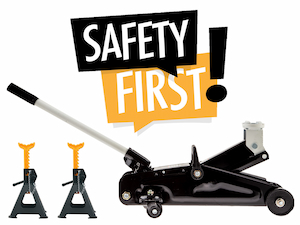
Jacks and jack stands are found in nearly every shop, garage, and job site, yet they’re also among the most misused. Understanding how they work, how to inspect them, and how to use them safely can prevent serious injuries and costly damage.
Know the Difference: Jacks vs. Jack Stands
A jack is designed to lift a load off the ground, not to hold it in the air for long periods. Some jacks are mechanical, like screw or ratchet jacks, while others are hydraulic, like bottle or floor jacks. The purpose of a jack is to raise a load smoothly and steadily.
Once a load is lifted, jack stands take over. These stands have a wide, stable base and a locking mechanism that holds the weight securely in place.
The jack does the lifting and the jack stands do the holding. Never rely on just a jack to hold up your heavy load.
Inspect Jacks and Stands Before You Lift
Before starting any lifting operation, take the time to inspect the equipment. A damaged jack or jack stand can fail without warning.
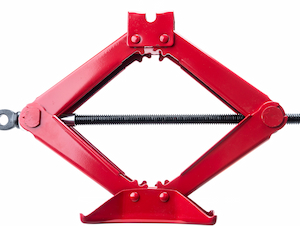
The jack’s frame should be straight and free of cracks or corrosion, and hydraulic jacks should show no signs of leaks. The lifting action should be smooth and steady, with no jerking or drifting. Check that all labels are clear and legible and that the load capacity markings can be easily read.
OSHA Standard 1910.244(a)(1) The operator shall make sure that the jack used has a rating sufficient to lift and sustain the load. The rated load shall be legibly and permanently marked in a prominent location on the jack.
Jack stands should have stable bases, and their support pins or ratchet bars should move freely and lock securely. Any sign of rust, bending, leaks, missing labels, or unauthorized repairs means the jack stands should not be used and should be taken out of service immediately.
OSHA Standard 1926.305(d)(1)(vi) and 1910.244(a)(2)(viii) Jacks which are out of order shall be tagged accordingly and shall not be used until repairs are made.
Set Jacks and Stands Up Safely
The surface beneath the jack and stands is just as important as the equipment itself. Always work on a firm, level surface and never put your jacks or jack stands on gravel, debris, or soft ground that could shift or sink under pressure. If the surface isn’t solid, use a steel plate or heavy blocking to create a stable foundation.
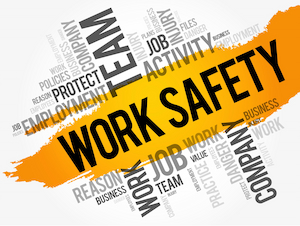
In the absence of a firm foundation, the base of the jack shall be blocked. If there is a possibility of slippage of the cap, a block shall be placed in between the cap and the load.
The jack must clearly display its weight limit, and it should never be loaded beyond that capacity. Center the load properly over a solid lift point and avoid raising just one side. Unbalanced lifting can cause the equipment or load to tip over.
OSHA Standard 1926.305(a)(1) The manufacturer's rated capacity shall be legibly marked on all jacks and shall not be exceeded.
Raise the load slowly and steadily, keeping all body parts away from the path of movement. Never stack blocks or spacers to extend the reach of a jack beyond its designed height.
Once the load is lifted, position the jack stands securely, lower the load gently onto them, and release the jack so it is no longer carrying weight.
Safe Support Practices with Jack Stands
When the weight is fully resting on the jack stands, take a moment to ensure everything is stable. Both stands should sit flat on the surface, directly under strong lift points or solid parts of the structure being supported.
Use stands in pairs so the load is balanced and never use two jack stands that are rated for different capacities. Makeshift supports like cinder blocks, wood stacks, or bricks should never be used as substitutes.
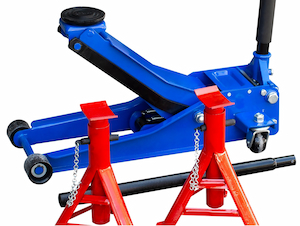
If multiple workers are involved, one person should be assigned to direct the lift and make sure everyone stays clear until the load is secure.
Never work beneath a raised load until you’ve confirmed that it is completely stable and properly supported.
Jack and Jack Stand Maintenance
Keeping jacks and jack stands in good condition is part of safe operation. Clean off dirt, oil, and grease to prevent corrosion and slipping hazards. Check for leaks or damage after lowering a load, since problems are often easier to spot immediately after use.
OSHA Standard 1926.305(d)(1)(iii) and 1910.244(a)(2)(v) All jacks shall be properly lubricated at regular intervals.
Remove from service any equipment that shows signs of damage or wear and never attempt unauthorized repairs or modifications. For jacks and jack stands, always follow the manufacturer’s instructions for proper operation, inspection, and maintenance.
Using jacks and jack stands correctly may seem straightforward, but it requires care, attention, and respect for the equipment. When used the right way these tools will continue to perform safely and reliably for a long time.
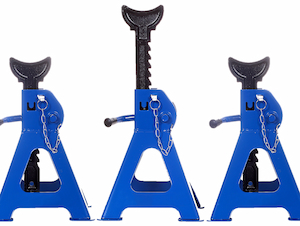
.jpg)

.jpeg)